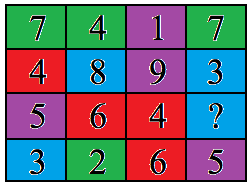As a way of reiterating @VassilisParassidis' answer from another perspective, the puzzle is reminiscent of a "connect wall" puzzle of which there are many examples on puzzle SE (e.g. here, here, and here.)
The thing to note is that the 4x4 layout is not ordered in any particular way - the items could just as easily be given as an unordered list of 16 items. There are four groups of four items - your job is to identify them.
Adding up all the known numbers, you have $7 + 4 + 1 + \ldots + 5 = 74$. Unlike the items in the connect wall puzzles which are linked by word association, the connection here must be derived from the numbers. One idea is that the numbers in each group sum to the same number. Of the four options (8, 6, 5, and 4) only one of these when added to 74 results in a number which is divisible by 4, namely 6. So, each group sums to $(74 + 6)/4 = 20$.
To verify that this actually works, we just need to find four groups of numbers that sum to 20. i.e.:

(Note that these groups are not unique, but the option from the multiple choice list is - only B (6) will work.)

